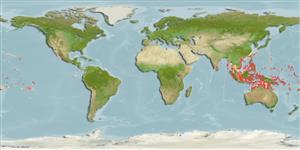Common names from other countries
Environment: milieu / climate zone / depth range / distribution range
Ökologie
seewasser riff-verbunden; tiefenbereich 15 - 110 m (Ref. 27115). Tropical; 23°C - 28°C (Ref. 27115); 30°N - 18°S
Pacific Ocean: Indonesia to the Marquesas and Society Islands, north to Ryukyu Islands, south to Scott Reef. Range extends to Easter Island (Ref. 9710). Closely related to Anampses lineatus from the western Indian Ocean.
Size / Gewicht / Alter
Maturity: Lm ? range ? - ? cm
Max length : 12.0 cm TL Männchen/unbestimmt; (Ref. 9710)
Rückenflossenstacheln (insgesamt) : 9; Rückenflossenweichstrahlen (insgesamt) : 12; Afterflossenstacheln: 3; Afterflossenweichstrahlen: 12. The primary phase of this species closely resembles that of A. meleagrides, but never has a uniformly yellow tail, and the color pattern does not change much with growth or sex (Ref. 1602). Recognized by the yellow bar on the base of the tail (Ref. 48636).
Adults occur in seaward reefs (Ref. 1602). Also in deep coastal to outer reef slopes and drop-offs (Ref. 48636). Solitary or in pairs in the surge zone, rarely to 30 m (Ref. 9710). They swim in small groups, each with several females and a single dominant male (Ref. 48636). Feed on small crustaceans, mollusks and polychaetes. Bury in sand at night (Ref. 9710). Oviparous, distinct pairing during breeding (Ref. 205). Maximum depth reported taken from Ref. 128797.
Life cycle and mating behavior
Maturities | Fortpflanzung | Spawnings | Egg(s) | Fecundities | Larven
Oviparous, distinct pairing during breeding (Ref. 205).
Myers, R.F., 1991. Micronesian reef fishes. Second Ed. Coral Graphics, Barrigada, Guam. 298 p. (Ref. 1602)
IUCN Rote Liste Status (Ref. 130435)
CITES (Ref. 128078)
Not Evaluated
Bedrohung für Menschen
Harmless
Nutzung durch Menschen
Fischereien: kommerziell; Aquarium: Kommerziell
Tools
Zusatzinformationen
Download XML
Internet Quellen
Estimates based on models
Preferred temperature (Ref.
115969): 25.3 - 29, mean 28 (based on 226 cells).
Phylogenetic diversity index (Ref.
82804): PD
50 = 0.5002 [Uniqueness, from 0.5 = low to 2.0 = high].
Bayesian length-weight: a=0.00977 (0.00470 - 0.02030), b=3.07 (2.89 - 3.25), in cm Total Length, based on LWR estimates for this (Sub)family-body shape (Ref.
93245).
Trophic level (Ref.
69278): 3.4 ±0.41 se; based on food items.
Widerstandsfähigkeit (Ref.
120179): hoch, Verdopplung der Population dauert weniger als 15 Monate. (Preliminary K or Fecundity.).
Fishing Vulnerability (Ref.
59153): Low vulnerability (10 of 100).
